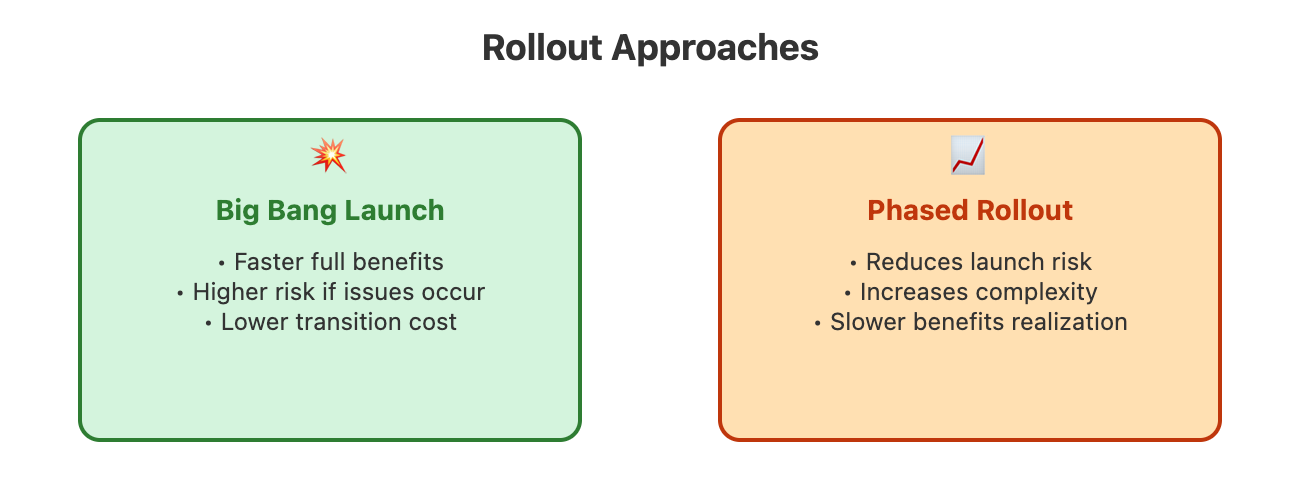Once you’ve narrowed your options, the HBR Guide to Building Your Business Case by Raymond Sheen stresses the importance of shifting from “What should we do?” to “How would we actually make this happen?”—but only at a high level. This is about outlining the major steps, not detailed project planning, to ensure your cost and benefit estimates are realistic. High-level planning at this stage helps you spot potential roadblocks and dependencies early, so you can build a more credible and achievable business case.
At this stage, identify major pre-work, such as cleaning up data, standardizing processes, or updating related systems, that must be done before implementation. Managers often overlook these steps, leading to underestimation of time and cost. For example, implementing a new system may require more extensive data migration or process documentation than initially thought. Sometimes, pre-work can also involve securing regulatory approvals, updating contracts, or aligning with other ongoing projects. These are factors that can significantly impact your timeline and budget if missed.
Here’s an example of how a conversation between team members might look when mapping out high-level implementation plans and surfacing pre-work and dependencies:
Chris: “Jessica, before we start planning the rollout, do you think we need to do any data cleanup or process updates?”
Jessica: “Definitely. Our current data is pretty inconsistent, and if we migrate it as-is, we’ll run into issues. We should probably allocate at least two weeks for data cleanup before we even start the migration.”
Chris: “Good point. I’ll add that as a major pre-work item in our high-level plan. Are there any other dependencies you see?”
Jessica: “We’ll also need to update some of our contracts with vendors, since the new system changes how we handle orders. That could take some time, depending on legal’s bandwidth.”
This conversation demonstrates the skills discussed in this lesson: proactively identifying major pre-work, surfacing hidden dependencies, and engaging team members to ensure nothing critical is overlooked. By asking open-ended questions and listening to input from others, Chris and Jessica are able to spot potential roadblocks early, make more realistic estimates, and build a stronger, more credible business case.
Once you have identified any major pre-work, decide on your rollout approach: a “big bang” launch or a phased rollout:
 Each has trade-offs for risk, cost, and speed of benefits. A phased approach may reduce risk but increase operational complexity and delay full benefits. Consider how each approach would affect different teams, customer groups, or regions, and whether you have the resources to support a more gradual transition. Thinking through these options at a high level helps you anticipate the main challenges and resource needs for each path, and prepares you to answer stakeholder questions about why you recommend a particular approach.
Each has trade-offs for risk, cost, and speed of benefits. A phased approach may reduce risk but increase operational complexity and delay full benefits. Consider how each approach would affect different teams, customer groups, or regions, and whether you have the resources to support a more gradual transition. Thinking through these options at a high level helps you anticipate the main challenges and resource needs for each path, and prepares you to answer stakeholder questions about why you recommend a particular approach.
The “messy middle” of change—the transition period when productivity and quality often dip as teams adjust to new systems or processes—is one of the most challenging and frequently underestimated phases of implementation. During this time, hidden or unexpected costs can emerge, such as spikes in help desk calls, increased error rates, and the need to run old and new systems in parallel. These transition costs can have a significant impact on your project’s success and stakeholder satisfaction if not properly anticipated.
Consider a major system change: after go-live, help desk volume can surge by 150-300%, forcing you to bring in overtime or temporary staff to handle the increased demand. Data migration may uncover issues that require additional cleanup, extending timelines and adding to costs. Running both old and new systems at the same time can double infrastructure expenses. You might also experience temporary drops in customer satisfaction or increased rework as employees adapt to new workflows. By identifying and planning for these transition costs up front, as the guide recommends, you demonstrate credibility, avoid budget surprises, and ensure your business case includes the necessary resources and contingencies for a smoother implementation.
Before finalizing your business case, it’s essential to confirm implementation roles with all affected departments. Too often, business cases assume resources or cooperation that aren’t actually available. Early conversations with department leaders help surface constraints, clarify responsibilities, and build support. This step is crucial for uncovering hidden dependencies, understanding competing priorities, and ensuring that everyone involved is aligned on what’s required.
It is key to approach these discussions collaboratively. You might ask departments how they see their role, rather than dictating tasks. This can reveal creative solutions and ensure buy-in. For example, a department might suggest a more efficient way to handle training or identify a key risk you hadn’t considered. Early role confirmation also helps you answer stakeholder questions about resource commitments with confidence, strengthening your business case and setting the stage for successful implementation. By involving departments early, you reduce the risk of last-minute surprises and increase the likelihood of a smooth rollout.
In the upcoming role-play sessions, you’ll have the opportunity to practice mapping a high-level implementation plan with your team. You’ll work through identifying major pre-work, choosing a rollout approach, and estimating transition and training needs. You’ll also practice engaging with other departments to confirm roles and surface potential roadblocks.
